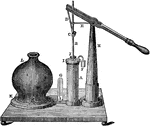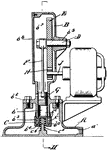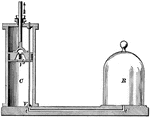
Air Pump
"The air pump is an instrument for removing air from a given space. A closed vessel R is called the…
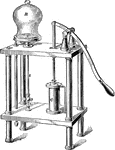
Air Pump
"The air pump is an instrument for removing air from a given space. A closed vessel R is called the…
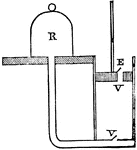
Air Pump
"The air pump is an engine by which the air can be pumped out of a vessel, or withdrawn from it. The…
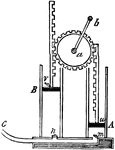
Air Pump
"The piston rods are furnished with racks, or teeth, and are worked by the toothed wheel a, which is…

Air Pump
"The air pump is an instrument for removing a gas from a closed vessel, the essential parts are shown."…
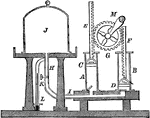
Double Barrel Air Pump
"Crank M raises and lowers the two pistons C and D. The valves allow only for air to be removed from…

Mechanical Action Air Pump
A pump is a device used to move fluids, such as liquids or slurries, or gases. A pump displaces a volume…

Air-Pump
"The general scheme of Geisler's pump is shown here. A and B are pear-shaped glass vessels connected…
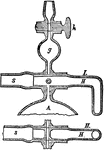
Air-Pump
"The general scheme of Geisler's pump is shown here. A and B are pear-shaped glass vessels connected…

Air-Pump
"This was invented in 1865 by H. Sprengel. The instrument, in its original (simplest) form, consists…

Centrifugal Pump
"A centrifugal pump differing from an ordinary centrifugal pumps in one feature only. The water rises…

Chain Pump
"It consists of a number of square pieces of board, or of thin iron, connected together through their…

Chain Pump
"Used to raise water with a continuous chain with evenly spaced circular plates. The plates exactly…

Chain-Pump
"The chain-pump consists of a tube or cylinder, the lower part of which is immersed in a well or reservoir,…
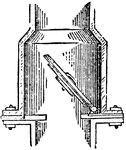
Clack-valve
"A valve in pumps with a single flap, hinged at one edge, and consisting of a plate of leather a little…
Condenser
"The operation of the condenser is the reverse of that of the air pump, and is a much more simple machine.…
Condenser
"Air is pumped down through shaft A through a downward opening valve into a given chamber. Connector…
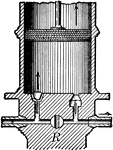
Condensing Pump
"The condensing pump is an instrument for compressing a gas into a closed vessel, as in pumping air…
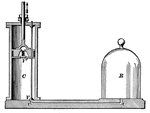
Pneumatic Devices
An air pump, which removes air from an enclosed space. R is the receiver and space that it encloses…

Savery's Engine
"Handle A opens and closes valves B and G. Steam is injected through pipe S which flushes any air/water…

Fire Engine
"The fire engine is a modification of the forcing pump. It consists of two such pumps, the pistons of…

Force pump
"The operation of the force-pump is similar to that of the suction-pump. The outlet-valve generally…

Steam-engine Force Pump
"The force-pump differs from others in having its piston solid, or without a valve, and also in having…

Forcing-Pump
"In the forcing-pump atmospheric pressure plays but a small part. There is no valve in the piston c,…
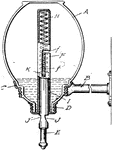
Liquid Soap Fountain
This soap dispenser is a device that when triggered dispenses a set amount of soap.

Hydraulic Press
"The pump barrel, a, b, is represented as divided lengthwise, in order to show the inside. The piston,…

Hydraulic Ram
"The Hydraulic Ram is a machine for raising water, and depending for its action on the impulse of flowing…

Magdeburg Hemispheres
"Grease the edges to make more sure of a tight joint, fit the hemispheres to each other, and exhaust…

Water Pulsometer
"An instrument of the pump kind for raising water, especially when that liquid is mixed with solid matter.…

Pump
"The common pump consists of a hollow tube, the lower part of which, descending into the water, is called…

Pump
"A device for raising liquids or removing gas from a closed vessel." Foster, 1921. The image shows two…
Atmospheric and Forcing Pump
"A curious combination of the atmospheric pump and the forcing pump, invented by Mr. Trevethick." -Comstock…
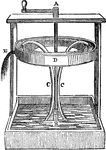
Centrifugal Pump
"The shaft A and B is attached to tubes, C. When the crank is turned, centrifugal force in the tubes…

Centrifugal Pump
"Some forms of centrifugal pump, however, have been designed for use with horse power and even for windmills."—Government…

Centrifugal Pump
This image is a centrifugal pump with one half of the casing removed. S is a hollow hub, a is a curved…

Chain Pump
"A Pump is a machine, engine, or device, consisting of an arrangement of a piston, cylinder, and valves,…

Common Metalic Pump
"This consists of a brass or iron barrel, A, containing at its upper part a hollow piston and valve…

Compression Pump
A machine used to keep blood and lymph flowing by pushing air through bands or sleeves that are placed…
!["A double-acting pump of the piston pattern is shown [here]. Such a pump has two sets of suction valves and delivery valves, one set for each side of the piston. With the piston moving in the direction of the arrow, the pressure of the atmosphere forces the water up the suction pipe P into the left-hand end of the pump cylinder, the left-hand suction valve opens and the left-hand delivery valve is closed...The water now flows up the delivery pipe P'." —Hallock 1905](https://etc.usf.edu/clipart/36100/36170/2act_fpump_36170_mth.gif)
Double-acting Force Pump
"A double-acting pump of the piston pattern is shown [here]. Such a pump has two sets of suction valves…
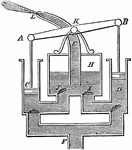
Fire Engine Pump
"Liquid is drawn up pipe F by pistons C and D. Once the liquid passes through the first set of valves,…

Force Pump
An illustration of a force pump which is used to force liquid up and expel it under pressure.

Force Pump
A force pump differs from a lifting pump for many reasons, with the main reason being that the force…

Forcing Pump
"Liquid is drawn up the pipe through the valve H. Piston G pushes the liquid through pipe, M, and into…

Forcing Pump
"The forcing pump is represented where A is a solid piston, working air tight in its barrel. There tube,…
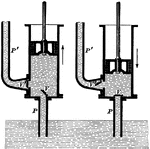
Forcing Pump
"As the piston ascends, as shown in the left-hand figure, the pressure of the atmosphere forces the…

Geissler Pump
An illustration of a Geissler pump. A pump is a device used to move fluids, such as gases, liquids or…

Geissler Pump
An illustration of a Geissler pump. A pump is a device used to move fluids, such as gases, liquids or…

General Purpose Pump
A device used to move fluids, such as liquids or slurries, or gases. A pump displaces a volume by physical…

Lift pump
"The lift pump or suction-pump consists of a cylinder or barrel, piston, two valves, and a suction pipe,…

Lifting Pump
"In some cases it is desired to raise water higher than it can be forced by the pressure of the atmosphere…
Lifting Pump
"Liquid is pumped up through pipe A, through valve H. The airtight piston G allows the liquid to pass…

Lifting Pump
A lifting pump is used when water needs to be raised to a greater height than what can be done with…
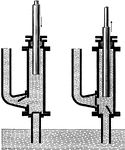
Plunger Pump
"The action does not differ in any way from that of the piston force pump. During the up stroke of the…

Sand Pump
"1. In rope-drilling, a cylinder, provided with a valve at the bottom, which is lowered into the drill-hole…

Sprengel Pump
The Sprengel pump is a vacuum pump invented by Hanover-born chemist Hermann Sprengel in 1865 while he…
